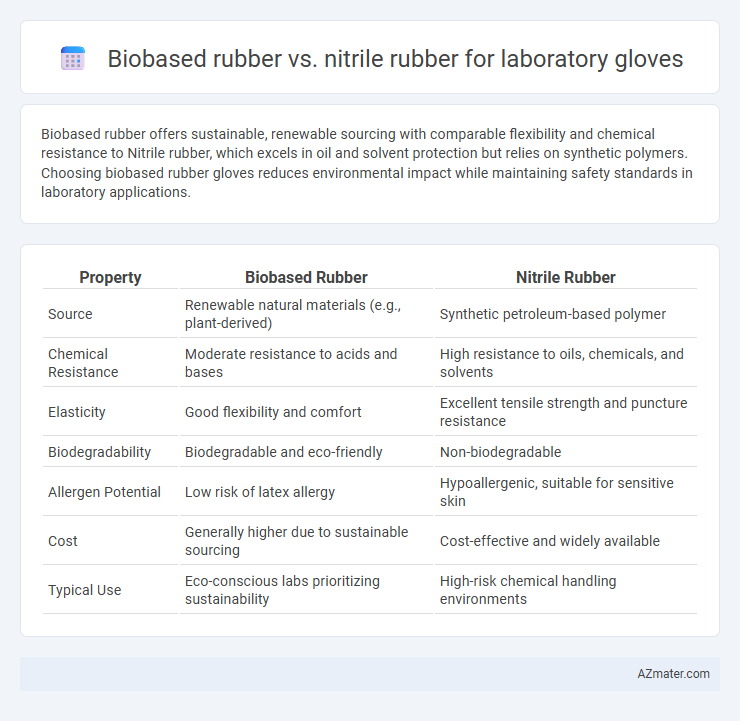Biobased rubber offers sustainable, renewable sourcing with comparable flexibility and chemical resistance to Nitrile rubber, which excels in oil and solvent protection but relies on synthetic polymers. Choosing biobased rubber gloves reduces environmental impact while maintaining safety standards in laboratory applications.
Table of Comparison
| Property | Biobased Rubber | Nitrile Rubber |
|---|---|---|
| Source | Renewable natural materials (e.g., plant-derived) | Synthetic petroleum-based polymer |
| Chemical Resistance | Moderate resistance to acids and bases | High resistance to oils, chemicals, and solvents |
| Elasticity | Good flexibility and comfort | Excellent tensile strength and puncture resistance |
| Biodegradability | Biodegradable and eco-friendly | Non-biodegradable |
| Allergen Potential | Low risk of latex allergy | Hypoallergenic, suitable for sensitive skin |
| Cost | Generally higher due to sustainable sourcing | Cost-effective and widely available |
| Typical Use | Eco-conscious labs prioritizing sustainability | High-risk chemical handling environments |
Introduction to Laboratory Glove Materials
Laboratory gloves commonly use biobased rubber and nitrile rubber, each offering distinct chemical resistance and durability. Biobased rubber, derived from natural sources like plant-based latex, provides biodegradability and improved environmental sustainability. Nitrile rubber, a synthetic copolymer of acrylonitrile and butadiene, delivers superior resistance to oils, chemicals, and punctures, making it a preferred choice for rigorous laboratory applications.
Overview of Biobased Rubber
Biobased rubber, derived from renewable natural sources like Hevea brasiliensis latex, offers a sustainable alternative to synthetic nitrile rubber in laboratory gloves. Its biodegradable properties and lower environmental impact make it preferable for eco-conscious applications, while maintaining comparable elasticity and puncture resistance. Biobased rubber also reduces dependence on petrochemical derivatives, aligning with green manufacturing practices in the medical and laboratory sectors.
Understanding Nitrile Rubber
Nitrile rubber is a synthetic copolymer of acrylonitrile and butadiene known for its exceptional resistance to oils, chemicals, and punctures, making it the preferred material for laboratory gloves requiring durability and chemical protection. Unlike biobased rubber, which derives from renewable natural sources and offers biodegradability, nitrile rubber provides superior strength and longer shelf life essential for high-risk laboratory environments. Its dense molecular structure enhances resistance to degradation from solvents and punctures, ensuring reliable barrier protection during hazardous chemical handling.
Environmental Impact: Biobased vs Nitrile Rubber
Biobased rubber gloves significantly reduce environmental impact through lower carbon footprints and enhanced biodegradability compared to nitrile rubber gloves, which are petroleum-derived and involve energy-intensive production processes. The sustainable sourcing of biobased rubber from natural latex promotes renewable resource use, while nitrile rubber contributes to microplastic pollution and persistent landfill waste due to its synthetic origin. Lifecycle assessments highlight biobased rubber gloves as a greener alternative, supporting circular economy goals and reducing ecological damage in laboratory settings.
Chemical Resistance Comparison
Biobased rubber offers moderate chemical resistance, particularly against alcohols and mild acids, but generally lacks the robust protection of nitrile rubber against oils, fuels, and a wide range of solvents. Nitrile rubber excels in resisting hydrocarbons, ketones, and certain acidic and alkaline substances, making it the preferred choice for laboratory gloves requiring enhanced durability and protection. In environments with aggressive chemicals, nitrile gloves provide superior barrier performance and longer service life compared to biobased rubber alternatives.
Durability and Strength Analysis
Biobased rubber laboratory gloves exhibit enhanced environmental sustainability while maintaining comparable elasticity, but generally demonstrate lower tensile strength and puncture resistance compared to nitrile rubber gloves. Nitrile rubber gloves provide superior durability and chemical resistance, making them ideal for rigorous laboratory applications involving harsh solvents and hazardous materials. Strength analysis consistently shows nitrile gloves outperform biobased variants in maintaining integrity under mechanical stress and repeated use.
Comfort and Fit: User Experience
Biobased rubber laboratory gloves offer enhanced stretchability and conform closely to hand contours, providing superior comfort during extended use. Nitrile rubber gloves, while resistant to chemicals and punctures, tend to be stiffer, which can reduce tactile sensitivity and lead to hand fatigue over time. Users often report that biobased rubber gloves deliver a more natural fit and improved dexterity, enhancing overall user experience in laboratory settings.
Allergenicity and Skin Sensitivity
Biobased rubber gloves, derived from natural sources like guayule or bacterial fermentation, exhibit lower allergenicity compared to traditional nitrile rubber gloves, which can sometimes trigger skin sensitivity due to chemical accelerators and additives. Nitrile gloves, while highly resistant to chemicals and punctures, often contain accelerators such as thiurams and carbamates that may induce allergic contact dermatitis in sensitive individuals. Choosing biobased rubber gloves can reduce the risk of allergic reactions and skin irritation, making them a preferable option for users with latex sensitivities or prone to skin conditions in laboratory settings.
Cost and Market Availability
Biobased rubber offers a sustainable alternative to nitrile rubber for laboratory gloves but generally comes at a higher cost due to limited production scale and raw material expenses. Nitrile rubber dominates the market thanks to its widespread availability, lower price, and reliable performance in chemical resistance and durability. The growing demand for eco-friendly products is gradually expanding biobased rubber's market presence, yet nitrile remains the cost-effective choice for most lab glove applications.
Future Trends in Laboratory Glove Materials
Biobased rubber for laboratory gloves is gaining traction due to its sustainable sourcing and reduced environmental impact compared to traditional nitrile rubber, which remains prevalent for its superior chemical and puncture resistance. Future trends indicate an increased integration of biobased polymers with enhanced durability and biodegradability to meet stringent safety standards while minimizing ecological footprint. Advances in polymer technology are driving hybrid materials that combine the biodegradability of biobased rubber with the performance characteristics of nitrile, promising more sustainable yet reliable laboratory glove options.

Infographic: Biobased rubber vs Nitrile rubber for Laboratory glove
 azmater.com
azmater.com